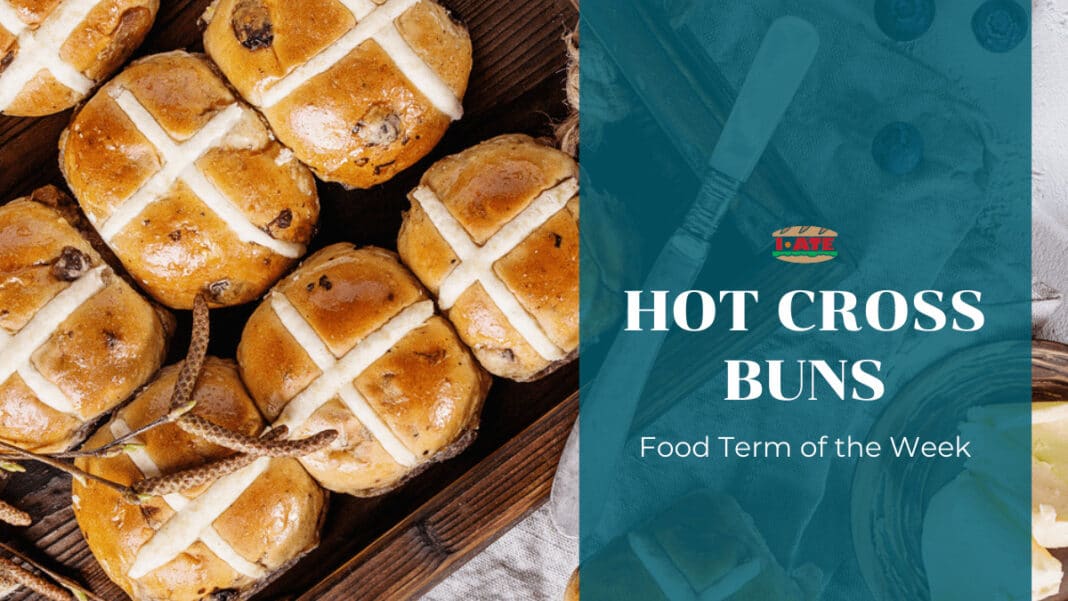It is a widespread European tradition to eat sweet breads in the period before Easter. In German speaking regions, a sweet bun called Heißwecke is consumed; Scandinavians eat a variety of sweet rolls called fastlagsbulle or fettisdagsbulle; in the Czech Republic and Slovakia, a sweet bread called Mazanec is eaten.
Hot Cross Buns are small buns decorated with a cross traditionally eaten on Good Friday in the United Kingdom and Ireland, but also in India, Canada, Australia, New Zealand, and the United States. They are a ‘spiced sweet bun’, which means that they contain spices such as cinnamon and nutmeg, in addition to sugar and raisins. Hot Cross Buns are usually cut in half, toasted, and eaten with butter. The distinctive cross is often made with either pastry strips or icing sugar.
The first written record of the word ‘Hot Cross Bun’ can be found in London in 1733. It is likely that Hot Cross Buns have existed for much longer than that, although their exact origins are unclear. Some have traced them back to Ancient Greece, where small cakes were decorated with a cross during springtime. Ancient Egyptians and Saxons also baked bread decorated with lines to honour their goddesses. Small buns with crossed lines – preserved by the ash of the Mount Vesuvius eruption – were even found in the ancient Roman city Herculaneum. Yet another theory is that the tradition was started in England in the 14th century, where a monk baked spiced buns and distributed them to the poor on Good Friday.
Historical records from England indicate that by the 16th century, ‘spiced breads’ were so popular that they were consumed all year round. In 1592, Queen Elizabeth I decreed that they can only be eaten on Christmas, Good Friday, and burials.
Today, supermarkets in English-speaking countries sell variations made with dried cranberries, blueberries, apples, candied orange peels and even chocolate or caramel. If you live in a country where Hot Cross Buns are not available, why not try and make them yourself? Try this recipe by Felicity Cloake.
Makes 16 Hot Cross Buns
 200ml milk, plus a little more for glazing
200ml milk, plus a little more for glazing
3 cardamom pods, lightly smashed with the flat side of a knife
1 cinnamon stick
2 cloves
¼ tsp grated nutmeg
Pinch of saffron
20g fresh yeast
50g golden caster sugar, plus extra to glaze
450g strong white flour
100g butter
½ tsp salt
½ tsp ground ginger
3 eggs
150g currants
50g mixed peel
3 tbsp plain flour
Heat 200ml milk in a pan along with the cardamom, cinnamon, cloves, nutmeg and saffron until just boiling. Turn off the heat and leave to infuse for 1 hour. Bring back to a boil and mix the strained milk with yeast and 1 tsp sugar. Tip the flour into a large mixing bowl and grate butter into it. Rub into flour with fingertips until well mixed, and add the rest of the sugar and salt and ginger. Beat 2 eggs. Make a well in the middle, and add the beaten eggs and the yeast mixture. Stir in, adding enough milk to make a soft dough – it should not look dry or tough. Knead for 10 minutes until smooth and elastic, then lightly grease another bowl, and put the dough into it. Cover and leave in a warm place until it has doubled in size – about 2 hours. Tip dough onto a lightly greased work surface and knead for a minute, flatten out and mix in currants and peel. Knead again to spread the fruit around evenly, then divide into 16 equal pieces and roll these into bun shapes. Put on lined baking trays and score a cross into the top of each, then cover and put in a warm place to prove until doubled in size. Pre-heat the oven to 200C and beat together the last egg with a little milk. Mix the plain flour with a pinch of salt and enough cold water to make a stiff paste. Brush the buns with the egg mixture, then, using a piping bag or teaspoon, draw a thick cross on the top of each. Put into the oven and bake for about 25 minutes until golden.
Sources
Thring, O. (2011) Consider the Hot Cross Bun. The Guardian. [Accessed 7 April 2020]
Hot Cross Buns. Practically Edible: The Web’s Biggest Food Encyclopaedia. Archived from the original on 3 April 2009. [Accessed 7 April 2020]
Nuwer, R. (2014) 5 Great Historical Myths And Traditions About Hot Cross Buns, a Pre-Easter Pastry. Smithsonian Magazine. [Accessed 7 April 2020]
Rohrer, F. (2010) How did hot cross buns become two a penny? BBC News Magazine. [Accessed 7 April 2020]
Heißwecke. Wikipedia. [Accessed 7 April 2020]
Cloake, F. (2011) How to cook perfect hot cross buns. The Guardian. [Accessed 7 April 2020]
 Written by Janna Mack. Born and raised in multilingual and multicultural Luxembourg, Janna speaks Luxembourgish, German, French, and English. She has degrees in Linguistics, Education, and Translation from the University of Glasgow, Scotland.
Written by Janna Mack. Born and raised in multilingual and multicultural Luxembourg, Janna speaks Luxembourgish, German, French, and English. She has degrees in Linguistics, Education, and Translation from the University of Glasgow, Scotland.

